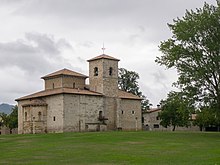Basilica of San Prudencio de Armentia
| Basilica of San Prudencio de Armentia | |
|---|---|
 View of the basilica | |
 | |
| 42°49′59″N 2°42′08″W / 42.833099°N 2.702198°W | |
| Location | Vitoria-Gasteiz, Álava, Basque Country |
| Country | Spain |
| Denomination | Catholic Church |
| Tradition | Latin Church |
| History | |
| Status | Parish church[1] |
| Architecture | |
| Style | Romanesque |
| Administration | |
| Archdiocese | Archidiocese of Burgos |
| Diocese | Diocese of Vitoria |
| Official name | Basílica de San Prudencio de Armentia |
| Type | Non-movable |
| Criteria | Monument |
| Designated | 1931 |
| Reference no. | RI-51-0000357 |
The Basilica of San Prudencio de Armentia (Spanish: Basílica de San Prudencio de Armentia, Basque: Armentiako San Prudentzioren basilika) is a basilica located in Armentia, Vitoria-Gasteiz, Basque Country, Spain. It was built in the 12th-century in Romanesque style.[2] The basilica lies on the Camino de Santiago.[3]
Originally dedicated to Saint Andrew, it was refurbished in 1776, destroying part of its original structure, although the apse and other isolated elements such were retained.[4] The last mayor works in the basilica took place after the partial collapse of the vault in 1961.[5] Despite the 1776 reform, it is considered one of the most important examples of medieval art in Álava. It was declared Bien de Interés Cultural in 1931[6] and Basque Cultural Heritage in 2012.[7]
Architecture
Built with a Latin cross layout, the vaults over the apse and crossing of its two arms are of special interest. The bases of the arches of the second of these vaults contain four sculptures of the evangelists. The capitals of the church are decorated with plant and animal motifs, as well as battle scenes between horsemen and centaurs. Its atrium contains the remains of the original portico. After being dismantled, stones from the portico were embedded in the walls in a disorderly fashion: the tympanum of the Lamb and that of Christ with the Apostles and the bas-reliefs of the Harrowing of Hell and the Sepulchre of Jesus, which represents one of the best Romanesque sculptural groups in the Basque Country.[citation needed]
-
General view of the portico
-
Relief of the victorious knight
-
Tympanum of the Ascension of Jesus
-
Tympanum of the Lamb
-
Reliefs depicting the Resurrection of Jesus and the Lamentation of Christ
The Basilica contains the image of San Prudencio,[citation needed] Bishop of Tarazona and patron saint of Álava from 1644, who according to tradition was born in Armentia. On April 28 each year, a procession and open-air festival are held on the meadows that surround the church in his honor.[8]
References
- ^ "Parroquias de la diócesis de Vitoria". Conferencia Episcopal Española (in Spanish). Retrieved 16 January 2023.
- ^ "223. Basílica de San Prudencio (Armentia, Vitoria)". euskadi.eus (in Spanish). Basque Government. Retrieved 16 January 2023.
- ^ López, Iratxe (18 February 2021). "Bilbao, 'Portu', Gernika... rutas por cinco tramos del Camino de Santiago sin alejarse de casa". El Correo (in Spanish). Retrieved 16 June 2024.
- ^ "Basílica of San Prudencio and San Andrés de Armentia". Álava Medieval / Erdi Aroko Araba. Retrieved 16 June 2024.
- ^ Sobrón Ortiz, Jesús (2006). "Obras ejecutadas en la basilica de San Prudencio de Armentia (1562-1982)" (PDF). Sancho el sabio: Revista de cultura e investigación vasca (in Spanish). 24: 131. Retrieved 16 June 2024.
- ^ "Iglesia de San Andrés (Cambio denominación en 1979, pasó a ser Iglesia de S. Prudencio, Patrono de Álava y Diócesis Vitoria)". Consulta a la base de datos de bienes inmuebles (in Spanish). Ministerio de Cultura y Deporte. Retrieved 16 January 2023.
- ^ "Basílica de San Prudencio". Ondarea (in Spanish). Basque Government. Retrieved 16 June 2024.
- ^ Pereda, Rubén (25 April 2024). "Álava celebra San Prudencio con retreta, misas y deporte: este es el programa alrededor del 28 de abril". elDiario.es (in Spanish). Retrieved 16 June 2024.
External links
 Media related to Basilica of San Prudencio de Armentia at Wikimedia Commons
Media related to Basilica of San Prudencio de Armentia at Wikimedia Commons





